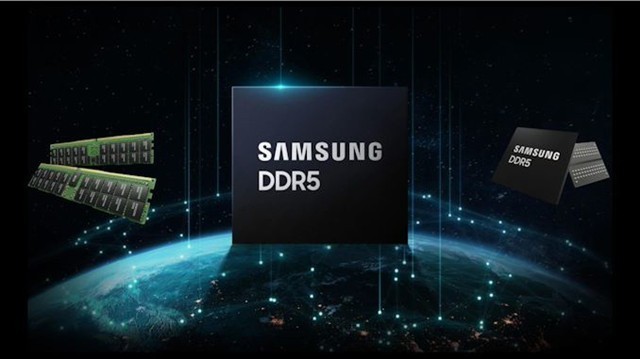DDR5- A New Generation Memory

Many manufacturers will launch a new generation of DDR5 memory this year. SDRAM chip manufacturers such as Micron, SK Hynix, Intel, or Samsung are also preparing for the arrival of new memories. DDR5 is the next evolution of DRAM. It brings a series of powerful new features designed to improve reliability, availability, and serviceability (RAS); reduce power, and significantly improve performance. DDR5 memory not only brings higher frequency and speed but also lower power consumption and ECC protection. According to analysts, the transition from DDR4 to DDR5 will be very fast, and the changes will take effect soon.
According to Yolle Developpement’s analysis, the transition between the two generations of memory should only take two years. This means that by 2023, the market share of DDR5 memory will be higher than that of DDR4. By 2026, the share of DDR4 RAM produced should fall below 5%. The entire DRAM market is expected to reach US$200 billion by 2026.
What are DDR4 and DDR5?
DDR4 is the fourth-generation double data rate (DDR) synchronous dynamic random access memory (SDRAM) released in the second half of 2014. DDR memory can send and receive data signals twice in one clock cycle. This is twice the possible rate of original DRAM integrated circuits produced in the 1970s, 1980s, and 1990s.
Although DDR5 is the fifth generation, great changes have taken place compared with the jump between DDR2, 3, and 4. The main driving force of DDR5 is the demand for more bandwidth. Current memory bandwidth cannot keep up with newer processor models with higher core counts.
DDR5 sets a higher standard than ever in terms of overall performance. It is pushing the limits of high-speed signal transmission in server applications. However, DDR5 is more than just a faster version of its predecessors. When comparing the bandwidth of DDR4 and DDR5 at the maximum data rate of DDR4 of 3200MT/s, the system-level simulation shows that the effective bandwidth of DDR5 has increased by 1.36 times. This comparison shows some of the overall design improvements introduced by DDR5. Increasing to 4800MT/s is expected to be the data rate available when DDR5 is released. And the potential increase in effective bandwidth jumps to 1.87 times. This is just a beginner! Driven by data rate increases and overall architecture changes, DDR5 will continue to increase system bandwidth to more than twice the current state.
All of these together achieve revolutionary performance enhancements that we have never seen before. In view of the current state of technology and the speed of major technological developments, in the next five years or so, DDR5 is likely to become the standard for many systems, similar to DDR4 replacing DDR3 and soon. From a technical point of view, this is good news.
Samsung announces development of 24 Gb DDR5 chip
At the last meeting dedicated to summarizing the results of the second quarter of this year, Samsung announced that it is developing 24Gb DDR5 memory chips. In theory, this would allow the production of up to 768 GB of memory modules for the server segment.
The company has demonstrated 512 GB RDIMM memory modules composed of 32 memory chips, each of which is 16 GB. Using 24Gb of memory as part of an eight-layer (8-Hi) component, Samsung can expand a single memory stack to 24GB and a total of 32 chip modules to 768GB. In this case, a server system that supports eight channels of memory (two modules per channel) can theoretically be equipped with more than 12 TB of DDR5 RAM. In contrast, the current-generation Intel Xeon Scalable (Ice Lake-SP) processor’s declared capabilities only provide up to 6 TB of memory installation.
For the server field, Samsung may start to produce 96, 192, or 384 GB memory modules. For the consumer RAM market, using 24 Gigabit chips instead of 16 Gigabit chips may mean a 50% increase in the number of memory modules. In this case, it will be possible to find 24 GB and 48 GB DDR5 memory modules on sale. However, the company added that such solutions are unlikely to appear in the near future. Because the focus now is to produce 16 Gb DRAM chips. However, we will find out more soon.
Samsung also uses high-k metal gate (HKMG) technology with metal gates and high-k dielectrics for traditional DDR instead of silicon dioxide insulators. The insulating layer is thinner, which reduces the amount of leakage current. And it also reduces the total energy consumption by up to 13%.
SK Hynix is about to start mass production
SK Hynix said that it used EUV technology to produce mobile 8Gb (1GB) LPDDR4 chips with a frequency of 4,266 MHz for the first time. Therefore, SK Hynix turned to its new production technology 1anm, which is the fourth iteration of 10nm technology (similar to 10nm+++). Therefore, it allows you to get 25% more chips per wafer.
SK Hynix will use the same technology on the new DDR5 chip and begin mass production in the second half of the year. It can be expected that everything is timed, so with the arrival of the new Intel Alder Lake platform, there will be enough chips that will support DDR5 memory.
SK Hynix also plans to start mass production of 176-layer NAND flash memory at the end of this year for future SSDs in 2022.
Intel XMP 3.0
Intel’s XMP 3.0 is also emerging, which is an extension of faster DDR5 memory. Intel XMP (Extreme Memory Profile) is an extension of general SPD (Serial Presence Detection) information that allows management to set the frequency, timing, and voltage of memory modules that exceed the JEDEC standard specifications.
The current maximum of DDR5 RAM is 6,400 MT/s, but the frequency is higher and Intel XMP 3.0 can be expected. Some memory manufacturers have released models of 7,200 MT/s, 8,400 MT/s, and 10,000 MT/s.
Micron’s DDR5
As early as January 6, 2020, Micron announced that it has begun to provide samples of DDR5 Registered DIMM (RDIMM) based on its industry-leading 1znm process technology.
The DDR5 TEP announced by Micron in July last year supports the ecosystem. It has now grown to more than 250 members from more than 100 companies. Leaders who have DDR5 products or built on platforms that support DDR5 are working hard to ensure a smooth transition to DDR5.
Conclusion
The largest expansion is expected to take place in 2022. When these memories will be supported by multiple platforms from Intel and AMD, including desktop computers and laptops, and of course servers. This will be the fastest expansion at the beginning. LPDDR5 can now be found on some mobile devices-support, such as Tiger Lake chip or Snapdragon 888 chipset. DDR5 RAM will become the standard configuration of mobile phones, tablets, and other devices.





